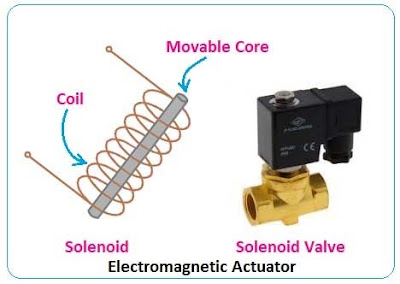What is Actuator? Examples, Applications, Types
Definition: An actuator is a mechanical or electromechanical device that converts a control signal into mechanical motion or movement by taking power from an energy source.
The control signal and energy source both may be electrical or gas pressure or liquid pressure or air pressure or any other form of energy. The actuator is very helpful for moving and controlling a mechanism. Actuators are available in almost every machine used in domestic to industrial. An actuator generally works as part of a machine and it moves or actuates by itself as well as actuates the other part of the machine or system.
Electric actuators are powered by electricity and use an electric motor to generate the necessary mechanical force. They can be operated using different control methods, such as switches, buttons, or electronic signals.
Types of Actuator
Actuators are divided according to their function, working principle, construction, and the form of energy they use. So, the different types of actuators are,
- Mechanical Linear Actuators - These Actuators use mechanical mechanisms, such as gears, belts, or screws, to convert rotational motion into linear motion for precise positioning or movement in a straight line.
- Mechanical Rotary Actuator - Rotary actuators that generate rotational motion through mechanical mechanisms.
- Hydraulic Linear Actuators - These actuators use hydraulic pressure to create linear motion.
- Hydraulic Rotary Actuator - It converts hydraulic pressure into rotational motion.
- Pneumatic Linear Actuators - These actuators are that utilize compressed air or gases to generate linear motion.
- Pneumatic Rotary Actuator - These actuators convert compressed air or gases into rotational motion.
- Electrical Linear Actuators - These actuators are powered by electricity, converting electrical energy into linear motion.
- Electrical Rotary Actuators - These actuators are driven by electricity, transforming electrical energy into rotational motion.
- Electromechanical Actuators - These combine electrical and mechanical components to convert electrical energy into mechanical motion.
- Electrohydraulic Actuators - Actuators that combine electrical and hydraulic mechanisms to generate mechanical motion.
- Thermal Actuators - Actuators that use thermal energy to induce mechanical motion or shape changes.
- Magnetic Actuators - Actuators that utilize magnetic fields to generate mechanical motion.
- Electromagnetic Actuators - Actuators are driven by electromagnetic forces to produce mechanical motion.
- Piezoelectric Actuator - Actuators that utilize the piezoelectric effect to convert electrical energy into mechanical motion.
- Soft Actuator - Actuators made from soft or flexible materials, capable of producing complex and adaptive motions.
You can observe actuators used everywhere around us. Different types of actuators have their own functions, advantages, and disadvantages. For different applications, different types of actuators are used. All the actuators required a control signal and a source of energy for their operation. When a control signal is applied to an actuator it takes power or energy from the energy source and makes movements or motions.
The actuator that moves or operates something in a straight or linear way is called a linear actuator and the actuator that moves or operates something in a rotational or circular motion is called rotary motion. These are the basic two types for all the actuators. Linear actuators are much more stronger and they are used for heavy loads also, whereas rotary actuators are most suitable for precise control, complex designing, etc. Nowadays, in automation systems actuators provides a very important role.
Read Also:
Actuators Examples
The common examples of actuators are,
- Rack and Pinion - mechanical liner type
- Chain Block Hoist - mechanical linear type
- Hydraulic Cylinder - hydraulic linear type
- Screw Jack - mechanical linear Type
- Solenoid - electromagnetic type
- Stepper Motor - electrical rotary type
- Thermal Bimorph - thermal
- Servo Mechanism - electrical rotary type
- Air Cylinders - pneumatic
- Pneumatic Cylinders - pneumatic
- Air Actuators - pneumatic
- Hard Disk Drives - electrical linear
- Printers - electrical linear
- Door Lock System - electromagnetic
- Damper Opening and Closing - electromechanical
- Bi Metalic Strips - thermal
- Piston - pneumatic
- Permanent Magnet Moving Coil(PMMC) Instruments - Magnetic
- 3D printers - soft actuator
- Sliding Door - linear
- Car Seat - linear
- Adjustable Chairs - linear
Read Also:
Applications of Actuator
1. Electrical actuators are mostly used in automation systems such as sliding doors, moving lights, aircraft, gaming zones, air conditioners, etc.
2. Pneumatic Actuators are very powerful and they are mostly used for industrial purposes and machinery.
3. Hydraulic actuators are used in cranes, lifting systems, digging machines, agriculture machinery, etc.
4. Electromagnetic actuators are used for operating valves, positioning, direction control systems, flow control, etc.
5. Soft actuators are used in compact devices, and smaller systems, for higher accuracy, control, and reliability.
Read Also:

